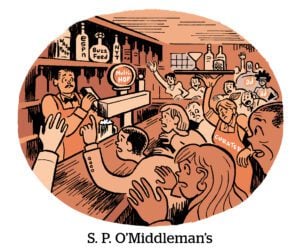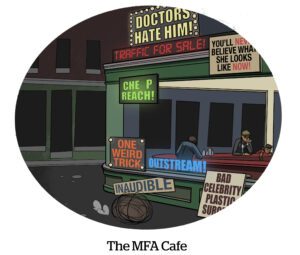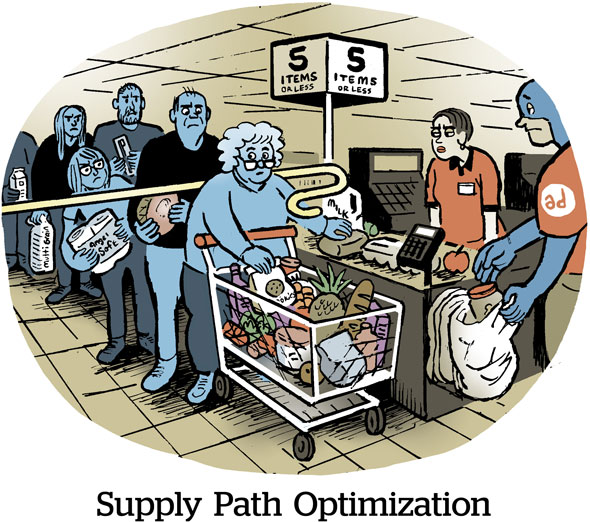Forget what you know about “made for advertising.” There’s a push now to redefine MFA as “made for arbitrage.”
Despite the backlash against MFA websites, there is still no industry standard to define MFA, which is causing problems for some publishers that feel unfairly lumped into the made-for-advertising category.
AdExchanger has learned that the 4A’s is hosting monthly meetings on the down-low between buyers and sellers to nail down more explicit criteria for what constitutes MFA. Participants include the ANA, IAB Tech Lab, the Brand Safety Institute and its Publisher Council and agency holding companies, as well as Jounce Media and DeepSee.io, whose research underpins most of the industry’s anti-MFA efforts.
Tech vendors, including DSPs, SSPs and ad verification companies, have thus far not been invited.
These meetings began last summer shortly after the ANA found that advertisers spend – or, more accurately, waste – 15% of their programmatic ad spend on low-quality clickbait sites every year.
The ‘A’ should stand for arbitrage, not advertising
It’s noteworthy that an agency trade organization is leading the charge to define MFA.
After all, agencies allowed MFA inventory to propagate because they included MFA publishers in their private marketplace deals to help them hit audience scale targets, said Scott Cunningham, chair of the Brand Safety Institute’s Publisher Council and lead on the Local Media Consortium’s NewsPassID initiative. “Now MFAs are bad, so agencies are trying to distance themselves.”
Still, Cunningham praised the 4A’s collaborative approach with publishers. As tensions over MFA reach a boiling point in the programmatic marketplace, participants in the 4A’s-led working group are advocating for a rational rather than a reactionary approach.
For example, instead of labeling any site that buys traffic or has an above-average ad load as MFA, the group is urging the industry to focus on publishers that deliberately game programmatic monetization through ad arbitrage.
And there has been some progress.
The 4A’s floated the arbitrage interpretation of MFA in September when it released guidelines to help agencies evaluate MFA websites.
And, as a result of these meetings, the Brand Safety Institute is developing a free, centralized database that all publishers will be able to use to check whether they’ve been labeled as MFA and then make changes to get off the list.
“The industry is coalescing around the idea that arbitrage business models are a fundamentally different animal” from over-monetized organic traffic, said Chris Kane, founder of Jounce Media, which licenses a widely adopted blocklist of MFA sites.
Jounce and DeepSee say they’ve always concentrated on arbitrage. But, going forward, they have committed to weight their MFA classification based primarily on whether the majority of a site’s traffic comes from arbitrage. Once they determine that, they will layer other factors like the ad load and the quality of the content.
Solidifying MFA criteria
But there are still plenty of areas of disagreement between buyers and sellers. For example, the ad-to-content-ratio question remains unsettled.
In its guidelines, the 4A’s say that if 30% of a desktop website is taken up by ads, it’s a clear sign of MFA.
But some participants in the working group think it’s a mistake to get too specific, said Rocky Moss, co-founder and CEO of DeepSee.io. Both Jounce and DeepSee worry that bad actors will use formalized MFA criteria as a playbook to fly just under the radar.
Publishers, meanwhile, are pushing for firmer standards from measurement companies on what constitutes MFA, as well as standards for what makes a desirable ad experience.
“It can’t be another black box,” said Justin Barton, SVP of digital strategy and partnerships at Black Enterprise and a participant in the 4A’s working group. “Measurement companies have to accept that there’s going to be some reverse-engineering.”
What’s so bad about arbitrage?
In most cases, MFA sites typically attract real human impressions, which means it isn’t technically fraud. But buyers have justifiable concerns about the terrible user experience that some publishers create for their paid traffic.
When publishers pay to promote their content on social media or through a native ad platform like Taboola, Outbrain, MGID or RevContent, they sometimes create alternate versions of their sites with much heavier ad loads. The purpose is to generate more money from ads than they spend to purchase the traffic.
On these sites, ads typically overwhelm the content on the page, which users hate and causes ads to get lost in the noise. Plus, these sites rely on tricks to maximize impressions, like rapid ad refresh rates and slideshows that force users to advance through multiple pages to read the full content.
MFA publishers take pains to hide these alternate sites from being accessed organically – for example, by de-indexing them from search and/or creating separate sub-domains to host them.
In other words, these sites are explicitly made for arbitrage – and it’s not just less-reputable long-tail publishers engaging in this practice. Mainstream pubs have been known to create these alternate ad experiences.
And, although native ad platforms are commonly associated with MFA, the vast majority of MFA activity actually comes from paid Facebook traffic, according to Kane.
The arbitrage model is nothing new. But as publishers rely more on paid traffic to offset losses in organic referrals from search and social media, they worry about getting characterized as MFA.
The fact is, most links shared through arbitrage networks don’t use shady monetization practices, Kane said, and buying traffic isn’t automatically a sign that a site is MFA.
Curing the label
But while buyers have their reasons for blocking MFA – often related to brand safety – the lack of formalized standards has caused a few missteps.
For example, Jounce’s early efforts to create an MFA blocklist incorrectly flagged some sites as engaged in arbitrage, Kane said. But these false flags were limited to “maybe 10 out of thousands” of publishers Jounce has identified as MFA, he said.
Jounce and DeepSee are both open to fielding inquiries from any site about its MFA status, and will work with publishers on curing the MFA label. At least one publisher that was flagged by Jounce as MFA for valid reasons has made changes to have this designation removed, Kane said.
Three publishers that are participating in the 4A’s MFA meetings confirmed to AdExchanger that Jounce and DeepSee have been responsive to their concerns. But they’re still worried that the curing process could become a paid service.
Jounce and DeepSee don’t charge for helping publishers remove the MFA label and have no plans to do so. But Integral Ad Science, which recently released its own anti-MFA solution, only offers curing services to its existing publisher clients.
And although Jounce itself is public about how it classifies sites, Cunningham said, publishers lack insight into how and when ad tech companies apply Jounce’s blocklist or other MFA-blocking solutions like those offered by DoubleVerify and Integral Ad Science.
That’s why the Brand Safety Institute, at the urging of its Publisher Council, is creating a centralized, free database for publishers to check their MFA status across multiple anti-MFA solutions, Cunningham said.
Both Jounce and DeepSee support this approach. However, Moss speculated that it could be hard to get legacy tech vendors onboard, because it could threaten their business.
Standards or suggestions?
Meanwhile, the 4A’s-led working group continues its efforts to define MFA. But, arguably, Jounce’s MFA blocklist is already considered by many to be a de facto standard.
The list has been adopted by DSPs (including The Trade Desk, AdTheorent and Basis Technologies), SSPs (including Kargo, OpenX, Sharethrough, PubMatic and Magnite), ad verification platform IAS – but, notably, not DoubleVerify or Oracle Moat – and agency holding companies (including GroupM).
But whether most of these companies are effectively using the list is different question. An Adalytics report released on Monday found that, with the exception of The Trade Desk, Basis and Kargo, the majority of ad tech companies are still transacting on MFA sites.
And the last thing publishers need, said Black Enterprise’s Barton, is to be at the mercy of yet another blocklist that must be constantly updated and could be misapplied.
“This should be done pre-bid,” Barton said, “where an SSP or DSP can block it based on the attributes on the site.”

















